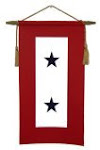Number One Son shipped out for Iraq Saturday October 20.

Words fail me.
Fortunately the Psalmist doesn’t have that problem:
…[4] he will cover you with his pinions, and under his wings you will find refuge;Flyboy is now blogging from the Sandbox as Cincinnatus at ThermopylaeUSA.
his faithfulness is a shield and buckler.
[5] You will not fear the terror of the night, nor the arrow that flies by day,
[6] nor the pestilence that stalks in darkness, nor the destruction that wastes at noonday.
[7] A thousand may fall at your side, ten thousand at your right hand; but it will not come near you...
[10] no evil shall befall you, no scourge come near your tent.
[11] For he will give his angels charge of you to guard you in all your ways.
[12] On their hands they will bear you up, lest you dash your foot against a stone.
---Psalm 91 [ 90 for us Papists -- but it's the Soldier's Psalm, and that designation doesn't work so well if you alter the numbering, as explained here.]
As always, a good read.
THAT WAR
It is hard to predict how many generations and/or conflagrations are yet to pass before our society (i.e., what we call the West) no longer knows instinctively which war is meant by the words “THE war.”
For now, for us, “THE war” is still World War II, so Ken Burns’ recent seven-part documentary needed no other title.
Based on Burns’ reputation as America’s best living TRUE documentary film-maker (as opposed to the relentlessly ballyhooed
 but
but reekingly FAKE documen-tarians, Michael Moore and Al Gore), the series was predicted to be his greatest work yet, focusing narrowly on a handful of people in just four smallish towns from the four winds of the contiguous United States: Waterbury, Connecticut to the east; Luverne, Minnesota to the north; Mobile, Alabama to the south; and Sacramento, California to the west.
The approach was deeply personal and poignant, never pretending to comprehend the full sweep of history or the panorama of the war. While it is perhaps unfair to criticize him for not making the film that others might wish he had made, it is fair comment to wonder about the ultimate worth of a documentary (however truthful) so limited in its perspective as to convey a defective understanding of historic moment which is the genesis of the story being told.
“The War” had genuine human interest at any given moment, but as a whole there was an unexpected and peculiar tedium creeping over it. And despite Burns’ claim that he was trying to tell stories that were true to the people and their time, untainted by present events and military (mis)adventures now in the making, one couldn’t shake the feeling that the material had been selected and shaped by the film-maker’s own strong opposition to war in Iraq.

This is not to say that there was any reason to question the truth of each veteran’s experience and his memory of it. But the sum of the parts had an overriding sadness and a sense of regret (regret!) that simply defy what most people of sound mind consider to be THE lesson of the Second World War: THAT THE CIVILIZED WORLD HAD NO CHOICE BUT TO FIGHT IT, AND THAT THE VICTORY WAS WORTH EVERY SACRIFICE ENDURED.
This sadness, and the regret, were the substance of honest reflections from one or two veterans (most notably and, frankly, most irritatingly, from Sam Hynes of Minnesota), whose stories made up the threads of the narrative. But for most of these men, no matter how wretched their suffering, it is difficult to believe that the most powerful impression they would want the viewer to come away with is one of regret. I don’t buy it.
Burns’ ma
 nages his material so as to suggest that, for the average soldier, no rationale for beating back the naked aggression of a fascist power ever made itself obvious to him until he saw for himself the concentration camps of Europe, or experienced the sadism of a Japanese prison commandant. I don’t buy that either. These citizen soldiers were not all simple, parochial, and ignorant of the consequences of letting tyranny prevail and gobble up continents. They weren’t all in a state of disconnection between the horrors of their own battlefields and the larger consequences for the world if their mission failed. Sorry-- I don’t buy it.
nages his material so as to suggest that, for the average soldier, no rationale for beating back the naked aggression of a fascist power ever made itself obvious to him until he saw for himself the concentration camps of Europe, or experienced the sadism of a Japanese prison commandant. I don’t buy that either. These citizen soldiers were not all simple, parochial, and ignorant of the consequences of letting tyranny prevail and gobble up continents. They weren’t all in a state of disconnection between the horrors of their own battlefields and the larger consequences for the world if their mission failed. Sorry-- I don’t buy it.Oddly (and, I suspect, unintentionally on Burns’s part), the view from within the tunnel of the veterans' experience of the war in the Pacific gradually made the best case I have ever heard for the dropping of the atomic bomb on Japan.
I have always struggled with that event. I do believe that the full scope of consequences of the bomb over the long, LONG term (such as radiation-related disease, deformity, and death, decades after the event) were probably unknown at the time, but there was never any doubt about the short-term catastrophe that the bomb would unleash. And arguments based on projected loss of life due to invasion vs. bombing have always been problematic. However, “The War” presented in searing clarity what may have been the determinative factor in the decision to bring hostilities in the Pacific to their quick and terrible end: the singularly crazed appetite of the Japanese for wholesale suicide.
Even in our modern society, in which an overt suicidal impulse has gained “respectability” through the euthanasia movement, and a more subtle cultural suicide of plummeting birthrates drifts toward irreversibility, still we can scratch our heads at Japan’s long history as a suicide culture. The honourable self-disembowelling of Sepuku is now the stuff of legend, but its logical offspring persist in Japan to this day, in the country’s disastrous abortion and birth-rate demographics and, more literally, in such incidents as the recent spate of group suicides arranged among strangers via the internet.

Civilian and military prisoners of war—men, women, the elderly, and the infants—who endured the sadism and racism of their Japanese captors knew that within this hierarchy human life was worthless. Soldiers, sailors, and Marines who confronted human waves of outgunned Japanese armies and masses of kami-kaze pilots in the “floating chrysanthemum” attacks, and who witnessed the forced or voluntary mass cliff-jumping suicides of cornered Japanese civilians, knew that they were fighting an enemy who would feel honour-bound to keep killing until there was no one left to kill or be killed.
Whatever the other arguments may be about the morality of any particular kind of weapon, or of the choice of targets, there seems to be no question that the crushing bombs of August 1945 spared both Allied and Japanese lives in the hundreds of thousands, compared to the certain costs of an invasion of Japan.
The Pacific theatre of World War II is far less well-understood than that of Europe, and even as I was underwhelmed with Ken Burns’ “The War,” I was grateful for its equal concentration on both theatres, and th
 e stark portrait of the tentacles of Japanese conquest in the Pacific. Japan and Germany were a perfect marriage of racist madness in quest of world domination. Had they triumphed in their ambitions, the two empires would very likely have turned on and eaten each other, probably on a battlefield carpeted with Chinese corpses.
e stark portrait of the tentacles of Japanese conquest in the Pacific. Japan and Germany were a perfect marriage of racist madness in quest of world domination. Had they triumphed in their ambitions, the two empires would very likely have turned on and eaten each other, probably on a battlefield carpeted with Chinese corpses. Ken Burns has described the subject of his latest documentary as something quite different from “The Good War” that it has so often been called. In fact he did his level best to counter that image-- but I don’t think he succeeded. The most revisionist of his veteran spokesmen, the aforementioned Sam Hynes of Minnesota, flew over a hundred bombing missions at Okinawa, for which he must be given due credit and honour (and lots of it). But of all the voices in “The War,” Mr. Hynes probably served the shortest time in active combat, that being several months in mid-1945. (I consider those like Glenn Frazier, imprisoned for four years, to have been in combat every minute of every day.)
His tone throughout the series was, not to put too fine a point on it, that of a classic “bleeding heart.” At one point he talked about going on a close-in bombing raid and taking out a building. “There may have been people in there. I may have killed some people. I hope I didn’t…” Then why were you there, sir? Was the building going to kill you? Or capture children in the Philippines? Or behead Chinese men and gut their pregnant wives? No, people were going to do that—Japanese people—the enemy. So don’t be such a retrospective weenie, Professor Hynes, just to keep your street-cred in the halls of Princeton.
In other interviews Hynes was prepared to call World War II a “just war”—but (clinging to the street-cred again) it was, in his opinion, “the last just war.”
I think it was the last just war that we went into with national belief in it being the right thing to do," said Hynes, 83, of Princeton, N.J…"We had been attacked by an enemy force. Roosevelt spoke to us all on the radio, told us this is the day that would live in infamy. Congress met and declared war. We did it right. We didn't just creep into war on false pretenses and say, 'Here we are at war.' It was the last war that everybody understood was just.Yes, read it (not very well-hidden) between the lines: “Bush’s war was crept into without the same justification.” Oh really? No attack by an enemy? No day of infamy? No congressional approval? With all due respect, Professor Hynes (and much is due), your memories of both long ago and last week are being filtered through ideology, and I suspect that much of the PBS audience for this documentary figured that out.
Burns’ decision to confine himself to four American any-towns has met with criticism, mostly because the concept seems to have left him short of interesting material as well as broader perspective. However, in my view he failed to make use even of the material likely to have been available from these four towns. Where were the women, taking up the slack in factories or learning to be tractor mechanics, to cite just one example? His most prominent female voice was that of Katherine Phillips, who was utterly charming but unquestionably upper class.
Other than those whose role in the film was to be part of the “oppressed minority” contingent, we heard little from those on the home front who were left to scrabble for their next meal in the absence of their bread-winners. The few dozen principal voices that weave the fabric of this story fall somewhat short of representing a cross-section of regular folks. They are not all the butcher, the baker, and the candlestick-maker, offering up long-suppressed accounts of the harrowing experiences no one else can understand. This small group seems disproportionately weighted towards professionals—lawyers, businessmen, professors, some of whom have published accounts of what they did in the war. Burns did not really live up to his own ambition to view the war through the eyes of the American "Everyman."
[Interestingly, the man made famous by Burns's "Civil War" epic, Major Sullivan Ballou, was similarly atypical. While the viewer may have had the impression that Sullivan was an ordinary and surprisingly articulate man, in fact his beautiful letter to his wife Sarah was the work of a Rhode Island politician and lawyer, with an educational pedigree parallelling that of the most prominent modern political families, the Kennedys and Bushes. And, like the grimmest letter highlighted in "The War"-- that of Quentin Aanenson to his fiancée-- Ballou's now famous letter was never mailed.]
Critics of “The War” have also bemoaned the repetitious use of still photos of certain landmarks in the four towns, like the movie theatres. While there was something a little ho-hum about returning to the same framework time and again, I was more irritated by repetitions in the slices of stock combat footage used. The re-use of certain bits of "kaboom" footage made the viewer too aware that at any given moment the pictures in view may have nothing whatever to do with the scene being described by the narrator.
I'm sure there are many battles and incidents for which there is no photographic record, so the temptation to fill in with representative pictures is powerful. But the impulse to illustrate every single incident referenced in the film with some clip or other had the effect of undermining its authenticity, and causing it to drift into mere visual distraction. (This probably made the film longer too. Not a plus-- it was plenty long, thank you).
During the pre-broadcast publicity blitz, Ken Burns was often heard to say that this film was to be the story of selected individuals from selected places, and “if you weren’t in this war or waiting anxiously for someone that you love to come back from the war, you’re not in our film.” He noted that there would be no retrospective commentators, even of the caliber of the esteemed Shelby Foote who had given the historian’s view of “The Civil War.”
Yet Burns still employed the sonorous voice-over of a narrator, one who was hardly objective. At one point he comments that the war "brought out the best and the worst of a generation and blended the two so that at times they became indistinguishable." This observation is controversial at best, denigrates the citizen soldiers, and is an editorial intrusion of the sort the film-maker himself has characterized as inappropriate to his project.
Negative criticism of “The War” was admittedly countered by much high praise, but at the end of the day it is fair to say that the audience was not only disappointed, it was disappointing— PBS released some initial figures for first-night audience numbers which turned out to be inflated by as much as 100%. (See here, here, and here.) Burns has one land-mark documentary monument to American socio-military history under his belt—“The Civil War”. It seems clear now that he does not have two. There was much that was of interest—moving, instructive, revealing—in “The War.” But this is a historical chapter which not only merits a vast panoramic treatment, its essential truths are ill-served by anything less—and Ken Burns’ “The War” is so much less than it should have been.
Rock-blogging from Newfoundland again.
Home soon, and back to our irregularly scheduled programme.


















